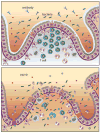Systemic effects of inflammation on health during chronic HIV infection
- PMID: 24138880
- PMCID: PMC4012895
- DOI: 10.1016/j.immuni.2013.10.001
Systemic effects of inflammation on health during chronic HIV infection
Abstract
Combination antiretroviral therapy for HIV infection improves immune function and eliminates the risk of AIDS-related complications but does not restore full health. HIV-infected adults have excess risk of cardiovascular, liver, kidney, bone, and neurologic diseases. Many markers of inflammation are elevated in HIV disease and strongly predictive of the risk of morbidity and mortality. A conceptual model has emerged to explain this syndrome of diseases where HIV-mediated destruction of gut mucosa leads to local and systemic inflammation. Translocated microbial products then pass through the liver, contributing to hepatic damage, impaired microbial clearance, and impaired protein synthesis. Chronic activation of monocytes and altered liver protein synthesis subsequently contribute to a hypercoagulable state. The combined effect of systemic inflammation and excess clotting on tissue function leads to end-organ disease. Multiple therapeutic interventions designed to reverse these pathways are now being tested in the clinic. It is likely that knowledge gained on how inflammation affects health in HIV disease could have implications for our understanding of other chronic inflammatory diseases and the biology of aging.
Copyright © 2013 Elsevier Inc. All rights reserved.
Conflict of interest statement
The authors have no conflicts of interest to declare.
Figures



Similar articles
-
Chronic HIV disease and activation of the coagulation system.Thromb Res. 2013 Nov;132(5):495-9. doi: 10.1016/j.thromres.2013.08.016. Epub 2013 Aug 29. Thromb Res. 2013. PMID: 24034985 Free PMC article. Review.
-
Th17, gut, and HIV: therapeutic implications.Curr Opin HIV AIDS. 2010 Mar;5(2):189-93. doi: 10.1097/COH.0b013e32833647d9. Curr Opin HIV AIDS. 2010. PMID: 20543599 Free PMC article. Review.
-
Circulating LPS and (1→3)-β-D-Glucan: A Folie à Deux Contributing to HIV-Associated Immune Activation.Front Immunol. 2019 Mar 18;10:465. doi: 10.3389/fimmu.2019.00465. eCollection 2019. Front Immunol. 2019. PMID: 30967860 Free PMC article. Review.
-
Residual immune dysregulation syndrome in treated HIV infection.Adv Immunol. 2013;119:51-83. doi: 10.1016/B978-0-12-407707-2.00002-3. Adv Immunol. 2013. PMID: 23886064 Free PMC article. Review.
-
Mucosal immunity in HIV infection: what can be done to restore gastrointestinal-associated lymphoid tissue function?Curr Opin Infect Dis. 2014 Jun;27(3):275-81. doi: 10.1097/QCO.0000000000000059. Curr Opin Infect Dis. 2014. PMID: 24739345 Review.
Cited by
-
Distinct lipid profile, low-level inflammation, and increased antioxidant defense signature in HIV-1 elite control status.iScience. 2021 Jan 28;24(2):102111. doi: 10.1016/j.isci.2021.102111. eCollection 2021 Feb 19. iScience. 2021. PMID: 33659876 Free PMC article.
-
Early Colorectal Responses to HIV-1 and Modulation by Antiretroviral Drugs.Vaccines (Basel). 2021 Mar 8;9(3):231. doi: 10.3390/vaccines9030231. Vaccines (Basel). 2021. PMID: 33800213 Free PMC article.
-
The Potential of Moringa oleifera to Ameliorate HAART-Induced Pathophysiological Complications.Cells. 2022 Sep 24;11(19):2981. doi: 10.3390/cells11192981. Cells. 2022. PMID: 36230942 Free PMC article. Review.
-
Elevation of Non-Classical (CD14+/lowCD16++) Monocytes Is Associated with Increased Albuminuria and Urine TGF-β1 in HIV-Infected Individuals on Stable Antiretroviral Therapy.PLoS One. 2016 Apr 20;11(4):e0153758. doi: 10.1371/journal.pone.0153758. eCollection 2016. PLoS One. 2016. PMID: 27097224 Free PMC article.
-
Retro-age: A unique epigenetic biomarker of aging captured by DNA methylation states of retroelements.Aging Cell. 2024 Oct;23(10):e14288. doi: 10.1111/acel.14288. Epub 2024 Aug 2. Aging Cell. 2024. PMID: 39092674 Free PMC article.
References
Publication types
MeSH terms
Substances
Grants and funding
LinkOut - more resources
Full Text Sources
Other Literature Sources
Medical

